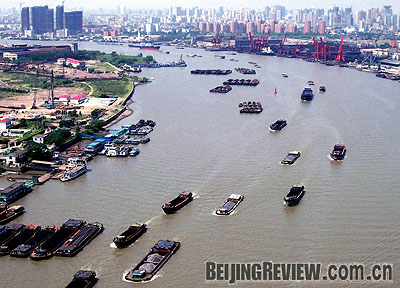|

TERTIARY AMBITION: The Yangtze River Delta will gain momentum from a new development blueprint that focuses on the service sector
The sprawling U.S. financial meltdown has sent a chill through some of China's export-oriented regions as they have shown symptoms of the American ailment in the form of declining exports. But you would not know it from watching the country's Yangtze River Delta, one of the growth engines of China's robust economy. Despite some nervousness about its slackening export machine, the delta has avoided following the Western world into an economic abyss. Instead, it is drawing some strength from a well-designed blueprint for developing a tertiary, or services, industry.
On September 16, the State Council issued a circular, approving the development program of the Yangtze River Delta as a world-class city cluster based on the productive service sector. The circular defines the Yangtze River Delta as the region covering Shanghai and neighboring Zhejiang and Jiangsu provinces.
The circular said the government aims to bolster the service sector as the leading economic powerhouse for the delta area by 2020 and vows to turn Shanghai into an international financial and shipping center. Moreover, the area would strive for a more advanced manufacturing sector by advancing its technological innovations for industrial upgrading, it said.
Du Ying, Vice Minister of the National Development and Reform Commission, told a press conference in Beijing on October 16 that the region is on course to grow into a well-off society by 2012, eight years in advance of other regions in the country.
Fear factor
The delta's ambition to develop a tertiary industry is motivated by fears that global economic growth may grind to a standstill and wind up eating farther into demands for Chinese exports. Labor and land cost surges also have set the stage for a recessionary environment for the area's manufacturing industry.
Several indicators have already hinted that the region is under pressures of an economic slowdown. According to the National Bureau of Statistics (NBS), Jiangsu Province's total volume of imports and exports from January to September grew 23.9 percent year on year, 4 percentage points lower than the year-earlier period. Meanwhile, the value of the industrial output of enterprises in Shanghai above a designated size, namely with an annual output value exceeding 5 million yuan ($731,500), only climbed a dismal 6 percent in September, slower than the average rate of 11.5 percent during the first three quarters of this year.
Guo Tianyong, Director of the Research Center of the Chinese Banking Industry under the Central University of Finance and Economics, told Beijing Review that a buoyant tertiary sector could help insulate the delta's economy from external downturns and make the composition of growth healthier given the region's unmatched weight in the national economy.
The latest data from the NBS indicate that although the region covers only 2.1 percent of the country's territory, it produces 22.5 percent of national gross domestic product, contributes 31.5 percent to national fiscal income and attracts 35 percent of all foreign investment to China.
Zuo Xiaolei, chief economist at China Galaxy Securities Co. Ltd., echoed Guo's opinion. "The focus switch of the delta is the latest in a string of extraordinary steps taken by the government to balance the economic structure's over-dependence on exports that are facing some headwinds," Zuo told Beijing Review.
An advanced manufacturing sector
While the drop in exports is partly because of overseas economic downturns, the seeds of real threats to China's manufacturing sector are more homegrown.
| 